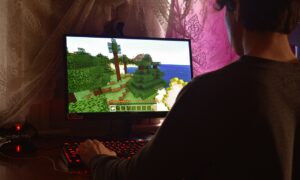The planet is in danger. In a dubious future, these advancements can be a power for advancement. Obviously, number one could likewise spell our fate. The planet is in danger. Consistently, it appears that imaginative and groundbreaking individuals are reacting to the rising interest in developments that are both helpful and environmentally cognizant.
A few items appear to be straight out of Black Mirror with their smooth, current structures—while others are still in their inconvenient preliminary stages. We’ve accumulated a rundown of ten green manifestations that give us trust later on for our planet. People are both causing and fighting with deforestation, sea fermentation, and climbing temperatures, to give some examples of our not exactly favorable inheritances.
Innovation is in a general sense changing the manner in which we live, work, identify with each other and to the outer world. The speed, broadness, and profundity of current achievements have no authentic or historical point of reference and are disturbing pretty much every division in each nation. Presently like never before, the coming of new innovation can possibly change ecological protection. It’s likewise significant that a portion of these advancements accompanies dangers of their own. Truth be told, our main best wager to help earth could likewise spell fate for our species. Yet, as I look at the threat landscape, just as the instruments a work in progress to help, some good faith can’t resist the urge to sneak in. Here are my picks for 10 innovations well on the way to help save the Earth.
Let’s get straight to the point. No human innovation can completely supplant ‘nature’s innovation’ culminated more than a huge number of years in conveying key administrations to support life on Earth. A gainful, assorted Natural(characteristic) world and a steady atmosphere have been the establishment of the achievement of our progress and will keep on being so in the future.
A key issue in past innovative insurgencies has been the delicacy with which we have taken for granted healthy natural framework(systems like woodlands, seas, stream bowls, river basins (all supported and kept up by biodiversity) rather than valuing these as an important condition to development or to improve.
Less dubious, consequently, perhaps the possibility that innovation has a task to carry out in making our planet a progressively agreeable and manageable spot for people to keep trudging along. Satisfying the grand title of this piece with a complete list of advances or Digital technologies that will enable our planet to endure is likely a losing suggestion. You’re likely not to disagree with some part of this list. That is alright. It’s what the remarks area is for; I’d love to get a notification from you. The most recent couple of decades have seen the mind-blowing increasing speed in creative innovation and deployment, however, it is the present combination of these advancements which could truly change our future.
Artificial Intelligence
Without a doubt, it might fate every one of us by means of any number of science fiction premises (atomic obliteration, key species destruction, the ascent of the robots) however artificial intelligence may be our most logical option figuring ourselves out of the grave state we wind up in. It is difficult to consider innovation and nature together however even advances like Artificial Intelligence (computer-based intelligence) that couldn’t be additionally expelled from the characteristic world are helping protection endeavors.
On a very basic level, AI will be the bedrock of our future endeavors to fix the harm previously done to the planet while making sense of versatile solution for sustaining our species’ vitality, nourishment, and water needs.
AI is affecting agricultural practices and will before long change how cultivating is done in industrialized countries, diminishing our dependence on pesticides and definitely bringing down water utilization. AI will cause self-ruling vehicles more to explore all the more proficiently, bringing down air contamination. AI is being sent by material researchers to create biodegradable substitutions to plastics and create methodologies to clean our seas, which get around 8,000,000 metric huge amounts of plastics yearly.
Biodegradable shopper(Packs)
They are produced using cassava root and natural starches. The identified plastic bag is one of the biggest threats to ocean ecosystems. Identified the plastic packs’ areas probably the greatest danger to the sea biological systems. Instead of expecting people to quit utilizing all packs, Kumala( founder of AVANI Eco) accepted he should structure a superior item that would make it simpler for individuals to make the move from plastic to eco-accommodating. After some tinkering, he made a biodegradable pack produced using cassava roots and common starches. They guarantee their greenness uproariously with the words “I AM NOT PLASTIC” marked to their sides. The bags are also harmless for animal consumption.
Plant-based plastics that biodegrade are one palatable solution, as they could, in principle, supplant a significant number of the plastic items as of now available for use. Not all bioplastics biodegrade, and the value of some creation methods is discussed. Some portion of turning into a capable shopper in the following decade will realize the existence cycle of the items we purchase, from creation to entropy.
BATTERIES
Power is the restricting variable keeping down great green technology. Wind and sun oriented, for instance, are fit for producing tremendous measures of power(electricity), however selection of the advances has been throttled by a significant inadequacy: Now and again it isn’t blustery or radiant. Electric autos, likewise, are making tremendous steps, however, until range increments and charging times reduce, fossil fuels are going to rule.
Water Bottles
From the outset, these reasonable cases look like something off the international Space Station, yet they really are consumable water bottles. The water you can eat is the brainchild of Skipping Rocks Lab, a “seaweed-tech” startup situated in London. They have made a sans waste option in contrast to plastic containers and cups. Serving the size of water is typified in a reasonable layer (much like the juice balls in boba tea) produced using an ocean growth separate.
The ocean growth doesn’t have a flavor without anyone else and can be eaten alongside the water. In the end, flavors might be added to the skin. Because the skin is 100% compostable, it doesn’t need to be eaten, however numerous individuals eat it for the “experience.” Pierre Paslier, the fellow benefactor of Skipping Rocks Lab, says of the packaging“You’re not expected to eat the peel of your orange or banana. We are trying to follow the example set by nature for our packaging.”
AIR-INK pens
The air that we inhale is brimming with toxic substances. Yet, Anirudh Sharma, organizer of AIR-INK, accepts that we can transform that peril into something helpful. His “contamination filled” pen demonstrates that contamination might be our most prominent asset.
Sharma says:
“The black color in the pen you use is made by burning fossil fuels to make ink. But you shouldn’t need to burn new fossil fuels just to make ink. Fossil fuels are already being burned.”
“There are seven different grades of Air-Ink, with different applications: Fabric, outdoor paints, art, graffiti, screen printing, etcWe process the captured pollution to remove the heavy metals and carcinogens but the inks used for artwork/graffiti,etc are not fit for inhalation/ingestion. This is similar for any other ink or paint.”
Initial, a cartridge, like the thoughtful found in printers, is appended to vehicles to gather carbon sediment from the autos(car)’ depletes. Next, the AIR-INK group expels poisons, for example, substantial metals. What is left is raw carbon, and that is then processed into a top-quality dark(black) ink and sold in a pen-like holder. One pen of AIR-INK contains 40-50 minutes of vehicle population and composes simply like an ordinary pen.
Paper Lab(Epson )
Epson Paper Lab is the world’s first office machine with a closed office paper reusing cycle utilizing a dry procedure. In contrast to the conventional recycling system or framework, which uses a lot of water, Paper Lab for all intents and purposes doesn’t utilize water (aside from the extremely limited quantity of water that is required to keep up the dampness level of the framework, however, the machine doesn’t expect association with the water supply framework and can be introduced in any office) .
By and large, the world produces 400 million tons of paper and cardboard yearly. Essential mash is for the most part utilized for paper creation, and reused waste paper represents 38% of the worldwide paper production. The primary feature or component of Paper Lab is that it is the first on the planet or Earth (as per Seiko Epson information for November 2016) an office paper handling machine that recycles utilized paper into another one utilizing a dry procedure.
Nebia Shower System
The Nebia Shower System is an honoree in the 2017 Advancement By Design Awards, Fast Organization’s yearly celebration of the best thoughts in structure. Showers squander a dumbfounding measure of water—up to 20 gallons of water for every 8-minute shower.
The Nebia shower framework tries to lessen its item’s water utilization by 70% without affecting “the shower experience.” By using similar advancements that designers use for rocket motors and therapeutic gadgets, the Nebia atomizes the water stream into little beads, permitting multiple times the surface region to be secured with just a small amount of the water volume; all while keeping up water weight and diminishing water wastage.
Robot Bees
Maybe the most Dark Reflection of all is the robot honey bee. Scientists at Japan’s National Establishment of Cutting edge Mechanical Science and Innovation have made an automated, honey bee-like drone in order to solve the fast decrease in the worldwide honey bee population.
The physically controlled automaton copies the procedure of cross-fertilization completed by bumblebees. Its base is shrouded in steed hair and a clingy gel substance. As the drone arrives on one bloom, dust adheres to its base, and after that rubs off onto the following blossom it visits.
While the underlying exploration of the strong mechanical “honey bees” gives some expectation, there’s still a lot of work to be done before a long haul, the practical and proficient arrangement is found. Meanwhile, the decrease of destructive pesticide use is a basic piece of the arrangement. Eventually, honey bees and automatons should work-related. Robots ought not to plan to supplant the genuine article.
Graphene
More grounded than steel, more slender than paper, more conductive than copper, graphene is really a wonder material—and as of not long ago a totally hypothetical one. Graphene is an ultra-dainty layer of graphite that was first found in 2004 at the College of Manchester. It is presently the subject of extraordinary research and hypothesis, with many anticipating it will be next in line after bronze, iron, steel, and silicon in proclaiming the social and technological advancement of our species.
A simple one-molecule thick, graphene is adaptable, straightforward, and exceptionally conductive, making it reasonable to an enormous scope of planet-recuperating applications. These incorporate water filtration, superconductors fit for moving vitality crosswise over huge separations with insignificant misfortune, and photovoltaic uses, to give some examples. By tremendously expanding efficiencies over current materials, graphene may demonstrate to be a foundation in our green resurrection.
Beer Bottle Sand
In 2017, DB Distilleries propelled Lager Jug Sand, a crusade intended to empower the reusing of glass brew bottles. The New Zealand distillery has manufactured a machine that smashes brew bottles into usable sand. The whole change procedure takes only five seconds. As the jug is embedded into the machine, a laser triggers a wheel of little steel hammers, which pummels the container into tiny bits.
In the interim, a vacuum framework expels silica residue and plastic names, abandoning 200 grams of sand substitute powder per bottle. The sand is then used to protect the seashores that are so fundamental to the Kiwi way of life. Later on, the bottling works intend to supply their sand to national roading tasks, business and private development, and even golf shelters.































































